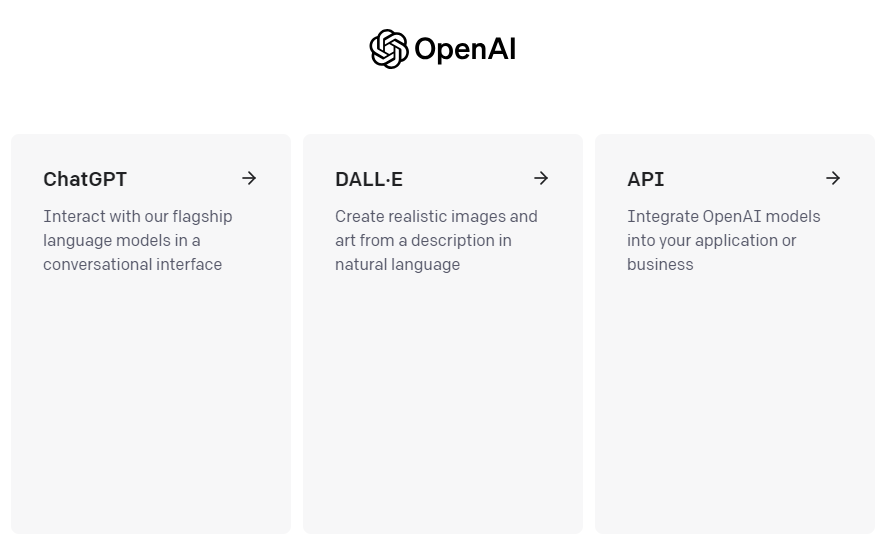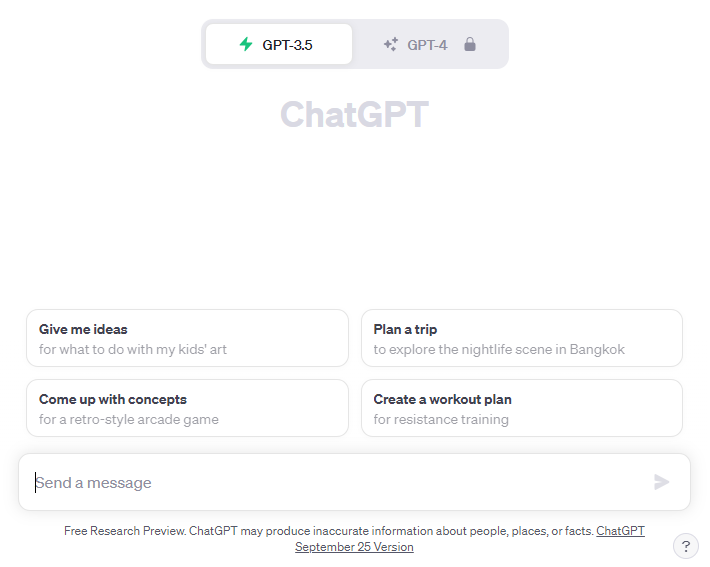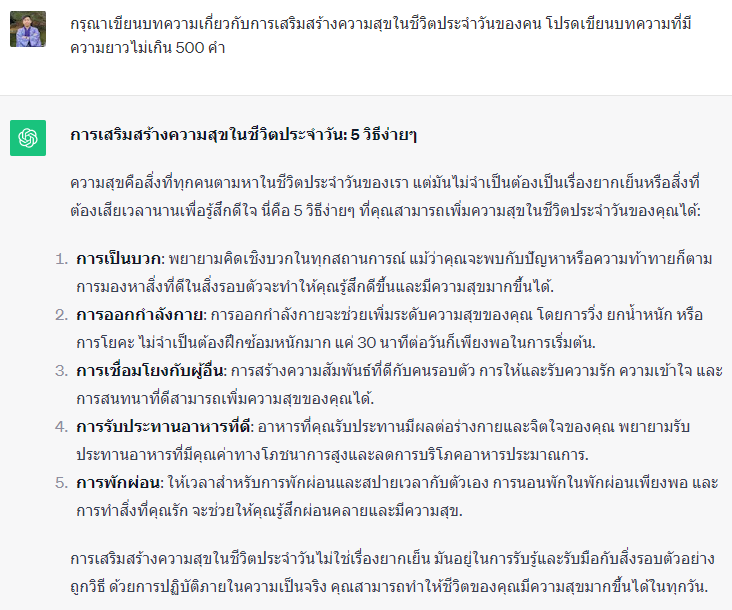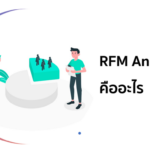
บทความนี้เขียนด้วย ChatGPT และผ่านการปรับปรุงโดยผู้เขียนและผู้ตรวจทาน รูปประกอบสร้างด้วย DALL-E AI
ChatGPT เป็นเทคโนโลยีที่ใช้ปัญญาประดิษฐ์ในการสร้างข้อความและบทความในรูปแบบที่คุณต้องการ (GPT-3 คืออะไร? ปัญญาประดิษฐ์ที่จะมาแย่งงานคนทั่วโลกในอนาคต!? – Big Data Thailand) ในบทความนี้เราจะสอนวิธีการใช้ ChatGPT ผ่านเว็บไซต์ OpenAI เพื่อเขียนบทความต่าง ๆ โดยให้คำแนะนำเกี่ยวกับวิธีการเข้าใช้งาน, การกำหนด Prompt, การปรับแต่งความยาวของบทความ, และวิธีการกำหนด Mood and Tone ของตัวบทความอย่างมีประสิทธิภาพ
สารบัญ
ขั้นตอนที่ 1: เข้าสู่ระบบในเว็บไซต์ OpenAI เพื่อใช้งาน ChatGPT
ให้เปิดเว็บเบราว์เซอร์และไปที่เว็บไซต์ OpenAI (https://www.openai.com/) คลิกที่ “Log In” แล้วเลือก ChatGPT

หลังจากเข้าสู่ระบบสำเร็จ คุณจะสามารถเข้าใช้ ChatGPT ได้
ขั้นตอนที่ 2: การกำหนด Prompt

หลังจากเข้าสู่ระบบ คุณจะเห็นหน้าจอ ChatGPT กำหนด Prompt เพื่อสั่งให้ ChatGPT เขียนบทความ โดย Prompt คือข้อความที่คุณพิมพ์ในช่อง “Send a message…” เริ่มต้น
คุณต้องกำหนด Prompt ให้เข้าใจง่าย หรือที่เรียกว่า “คำสั่ง” ซึ่งเป็นประโยคหรือข้อความที่คุณจะใช้สร้างบทความ ตัวอย่าง:
- Prompt 1: “กรุณาเขียนบทความเกี่ยวกับการเสริมสร้างความสุขในชีวิตประจำวันของคน”
- Prompt 2: “เขียนบทความเกี่ยวกับทฤษฎีทางวิทยาศาสตร์ที่อธิบายการกระทำของคนในสถานการณ์ฉุกเฉิน”
- Prompt 3: “เขียนบทความเกี่ยวกับประโยชน์ของการอ่านหนังสือทางด้านการพัฒนาตัวเอง”
ขั้นตอนที่ 3: ปรับแต่งความยาวของบทความ

หากคุณต้องการบทความยาวหรือสั้นกว่าที่ ChatGPT สร้างให้ คุณสามารถควบคุมความยาวได้ด้วยการระบุจำนวนคำหรือความยาวนั้นคือเท่าใดใน Prompt เช่น:
- “โปรดเขียนบทความที่มีความยาวไม่เกิน 500 คำ”
- “ให้บทความมีความยาวประมาณ 800-1000 คำ”
หรือ ให้ระบุคำสั่งเพิ่มเติม เช่น
- “เพิ่มข้อมูลเกี่ยวกับสาเหตุและผลกระทบของปริมาณขยะพลาสติก”
- “สรุปเท่าที่จำเป็นเกี่ยวกับการลดปริมาณขยะพลาสติก”
ขั้นตอนที่ 4: กำหนด Mood and Tone ตัวบทความ

หากคุณต้องการให้บทความมี Mood หรือ Tone ที่เฉพาะเจาะจง เช่นเข้มงวดหรือเบาบาง คุณสามารถระบุได้ใน Prompt โดยระบุ Mood หรือ Tone ที่คุณต้องการ เช่น:
- “กรุณาเขียนบทความเกี่ยวกับแฟชั่นในลักษณะที่เป็นทางการและเข้มงวด”
- “ให้บทความมี Tone ของการบรรยายเหมือนเสียงพูดของเพื่อนสนิท”
ตัวอย่างของ Prompt และ Mood/Tone:
- Prompt: “เขียนบทความเกี่ยวกับการท่องเที่ยวในประเทศไทย”
- Mood/Tone: “ให้บทความมี Mood ของความสนุกสนานและแฟนตาซี”
ผลลัพธ์ที่คุณได้:
“การท่องเที่ยวในประเทศไทยเป็นประสบการณ์ที่น่าสนุกสนานและจะทำให้คุณหลงใหลในความหลากหลายของทรัพยากรธรรมชาติและวัฒนธรรมที่นี่มีอย่างไม่ต่ำ. จากชายหาดที่งดงามในภาคใต้ไปจนถึงภูเขาที่อัศจรรย์ในภาคเหนือ ประเทศไทยมีอะไรมากมายที่คุณสามารถสัมผัสและสนุกกับในทุกมุม ถ้าคุณชื่นชอบการผจญภัย คุณสามารถเดินป่าในที่สุดของโลกที่คือเขาอินทนนท์ หรือถ้าคุณต้องการความผ่อนคลาย คุณสามารถเลือกพักผ่อนบนเกาะสวรรค์ที่สวยงามเช่นพังงาหรือภูเก็ต. ที่นี่มีอะไรมากมายที่คุณสามารถสนุกกับการท่องเที่ยวแบบของคุณ ดังนั้นมาสนุกกับประสบการณ์การท่องเที่ยวที่น่าจดจำในประเทศไทย!”
ขั้นตอนที่ 5: การตรวจสอบและปรับปรุง

หลังจาก ChatGPT สร้างบทความให้คุณ คุณควรตรวจสอบและปรับปรุงข้อความตามความเหมาะสม และเพิ่มรายละเอียดเพิ่มเติมตามที่ต้องการ เมื่อคุณพอใจกับบทความที่ได้ คุณสามารถบันทึกและนำไปใช้งานตามที่คุณต้องการ เช่น ในเว็บไซต์ของคุณ บล็อก หรืองานวิชาการ
บทสรุป
การใช้ ChatGPT เพื่อเขียนบทความนั้นเป็นกระบวนการที่สนุกและมีประสิทธิภาพ แต่ควรจำไว้ว่าคุณควรตรวจสอบความถูกต้องและคุณภาพของข้อความที่สร้างขึ้นเสมอ เพื่อให้ได้ผลลัพธ์ที่ดีที่สุดในการใช้ ChatGPT ในการเขียนบทความของคุณและสร้างประสบการณ์ที่น่าจดจำสำหรับผู้อ่านของคุณ
เนื้อหาโดย ณัฐพัชร์ เศรษฐเสถียร และ นนทวิทย์ ชีวเรืองโรจน์
ตรวจทานและปรับปรุงโดย อิสระพงศ์ เอกสินชล
Data Scientist Expert
Government Big Data institute (GBDi)
- Nuutthapachr Sethasathienhttps://temp.bdi.or.th/en/author/nj/
- Nuutthapachr Sethasathienhttps://temp.bdi.or.th/en/author/nj/
- Nuutthapachr Sethasathienhttps://temp.bdi.or.th/en/author/nj/31 January 2022
- Nuutthapachr Sethasathienhttps://temp.bdi.or.th/en/author/nj/
- Nontawit Cheewaruangroj, PhDhttps://temp.bdi.or.th/en/author/nontawit/
- Nontawit Cheewaruangroj, PhDhttps://temp.bdi.or.th/en/author/nontawit/
- Nontawit Cheewaruangroj, PhDhttps://temp.bdi.or.th/en/author/nontawit/
- Nontawit Cheewaruangroj, PhDhttps://temp.bdi.or.th/en/author/nontawit/27 February 2023
Senior Project Manager & Data Scientist at Big Data Institute (Public Organization), BDI
- Isarapong Eksinchol, PhDhttps://temp.bdi.or.th/en/author/isarapong/
- Isarapong Eksinchol, PhDhttps://temp.bdi.or.th/en/author/isarapong/
- Isarapong Eksinchol, PhDhttps://temp.bdi.or.th/en/author/isarapong/
- Isarapong Eksinchol, PhDhttps://temp.bdi.or.th/en/author/isarapong/






















